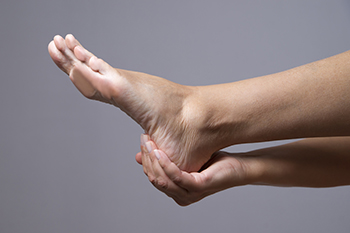Items filtered by date: December 2022
Active Children and Foot Pain

The chances may increase for a foot injury to occur in children who participate in sports activities. These types of injuries can involve the ligaments, bones, and tendons. Fractures and sprains also fall into this category. There are two classifications of foot injuries that can develop, consisting of acute or chronic. Acute injuries consist of contusions, or bruises, fractures, and sprains. Chronic injuries can include stress fractures and tendonitis, and generally happen gradually from overuse. Parents may see symptoms in their children in the form of limping or difficulty walking. At this point, a proper diagnosis is necessary to have, which can determine what type of injury it is. Many times an X-ray or MRI is performed, and this can precede what type of treatment is needed for a complete recovery. If your child has foot pain, it is strongly urged that you seek the counsel of a podiatrist who can guide you toward helping your child find relief.
Making sure that your children maintain good foot health is very important as they grow. If you have any questions, contact one of our podiatrists of Houston Foot and Ankle Care. Our doctors can provide the care you need to keep you pain-free and on your feet.
Keeping Children's Feet Healthy
Having healthy feet during childhood can help prevent medical problems later in life, namely in the back and legs. As children grow, their feet require different types of care. Here are some things to consider...
Although babies do not walk yet, it is still very important to take care of their feet.
Avoid putting tight shoes or socks on his or her feet.
Allow the baby to stretch and kick his or her feet to feel comfortable.
As a toddler, kids are now on the move and begin to develop differently. At this age, toddlers are getting a feel for walking, so don’t be alarmed if your toddler is unsteady or ‘walks funny’.
As your child gets older, it is important to teach them how to take care of their feet.
Show them proper hygiene to prevent infections such as fungus.
Be watchful for any pain or injury.
Have all injuries checked by a doctor as soon as possible.
Comfortable, protective shoes should always be worn, especially at play.
If you have any questions please feel free to contact our offices located in Inner Loop, Southwest, Greater Heights, and Pearland, TX . We offer the newest diagnostic and treatment technologies for all your foot and ankle needs.
Arthritis Can Cause Pain in the Feet and Ankles
How to Know if You Have a Broken Foot

A broken foot can occur from a fall or being hit by an object. Those with osteoporosis, a bone condition often seen in older adults where bones are more likely to be weak or brittle, should be particularly careful of broken bones. Signs of a broken foot are pain, swelling, and deformity. A snap or grinding noise may be heard at the time of injury, and there may be swelling, bruising, or tenderness near the injured area. It will also likely be painful to bear weight on the affected foot. If you suspect a break, elevate the foot, and make an appointment with a podiatrist who can evaluate the injury and determine the correct treatment for you.
A broken foot requires immediate medical attention and treatment. If you need your feet checked, contact one of our podiatrists from Houston Foot and Ankle Care. Our doctors can provide the care you need to keep you pain-free and on your feet.
Broken Foot Causes, Symptoms, and Treatment
A broken foot is caused by one of the bones in the foot typically breaking when bended, crushed, or stretched beyond its natural capabilities. Usually the location of the fracture indicates how the break occurred, whether it was through an object, fall, or any other type of injury.
Common Symptoms of Broken Feet:
- Bruising
- Pain
- Redness
- Swelling
- Blue in color
- Numbness
- Cold
- Misshapen
- Cuts
- Deformities
Those that suspect they have a broken foot shoot seek urgent medical attention where a medical professional could diagnose the severity.
Treatment for broken bones varies depending on the cause, severity and location. Some will require the use of splints, casts or crutches while others could even involve surgery to repair the broken bones. Personal care includes the use of ice and keeping the foot stabilized and elevated.
If you have any questions please feel free to contact our offices located in Inner Loop, Southwest, Greater Heights, and Pearland, TX . We offer the newest diagnostic and treatment technologies for all your foot and ankle needs.
Changing Shoes May Provide Relief for Morton’s Neuroma

The digital nerve in the feet is defined as the nerve that transports sensations to and from the toes. If this nerve becomes irritated or inflamed, it can cause severe pain and discomfort, often causing difficulty in walking. Morton’s neuroma is a foot condition that affects women more than men, and this can be a result of frequently wearing high heels. These types of shoes generally have limited room for the toes to move freely in, and the digital nerve can become compressed. It is located between the third and fourth toes, and the sensation that is felt can be likened to having a marble in the shoe. Additional symptoms can include a numbing feeling, and pain may occur in the ball of the foot. Relief is often found when high heels are eliminated, and it is suggested to wear shoes that are flat or have a lower heel. If you are afflicted with Morton’s neuroma, please speak to a podiatrist who can guide you toward the correct treatment options, which may include surgery for repair or removal of the nerve.
Morton’s neuroma is a very uncomfortable condition to live with. If you think you have Morton’s neuroma, contact one of our podiatrists of Houston Foot and Ankle Care. Our doctors will attend to all of your foot care needs and answer any of your related questions.
Morton’s Neuroma
Morton's neuroma is a painful foot condition that commonly affects the areas between the second and third or third and fourth toe, although other areas of the foot are also susceptible. Morton’s neuroma is caused by an inflamed nerve in the foot that is being squeezed and aggravated by surrounding bones.
What Increases the Chances of Having Morton’s Neuroma?
- Ill-fitting high heels or shoes that add pressure to the toe or foot
- Jogging, running or any sport that involves constant impact to the foot
- Flat feet, bunions, and any other foot deformities
Morton’s neuroma is a very treatable condition. Orthotics and shoe inserts can often be used to alleviate the pain on the forefront of the feet. In more severe cases, corticosteroids can also be prescribed. In order to figure out the best treatment for your neuroma, it’s recommended to seek the care of a podiatrist who can diagnose your condition and provide different treatment options.
If you have any questions, please feel free to contact our offices located in Inner Loop, Southwest, Greater Heights, and Pearland, TX . We offer the newest diagnostic and treatment technologies for all your foot care needs.
All About the Arches of the Feet

The arches of the feet work as a spring that bears the weight of your body whenever you take a step. Most people are familiar with the arch on the inner sole of the midfoot. However, three separate arches combine to form a triangle in the feet that absorb the shock of walking and running. There are two longitudinal arches, medial and lateral, that run along either side of the foot from the heel to the top of the 1st and 5th metatarsal. Plus there is a transverse arch that runs across the midfoot, connecting the tops of the metatarsals. These three arches are supported by a number of ligaments, muscles, tendons, and bones that all help to support the weight of the body. When the medial longitudinal arch is too high, it causes a condition called pes cavus, which can be painful and cause gait problems. When the longitudinal arches collapse, it results in flat feet, known as pes planus. Both conditions, which can affect the way you carry out your daily activities, can be diagnosed and treated by a podiatrist.
If you have any concerns about your feet, contact one of our podiatrists from Houston Foot and Ankle Care. Our doctors can provide the care you need to keep you pain-free and on your feet.
Biomechanics in Podiatry
Podiatric biomechanics is a particular sector of specialty podiatry with licensed practitioners who are trained to diagnose and treat conditions affecting the foot, ankle and lower leg. Biomechanics deals with the forces that act against the body, causing an interference with the biological structures. It focuses on the movement of the ankle, the foot and the forces that interact with them.
A History of Biomechanics
- Biomechanics dates back to the BC era in Egypt where evidence of professional foot care has been recorded.
- In 1974, biomechanics gained a higher profile from the studies of Merton Root, who claimed that by changing or controlling the forces between the ankle and the foot, corrections or conditions could be implemented to gain strength and coordination in the area.
Modern technological improvements are based on past theories and therapeutic processes that provide a better understanding of podiatric concepts for biomechanics. Computers can provide accurate information about the forces and patterns of the feet and lower legs.
Understanding biomechanics of the feet can help improve and eliminate pain, stopping further stress to the foot.
If you have any questions please feel free to contact our offices located in Inner Loop, Southwest, Greater Heights, and Pearland, TX . We offer the newest diagnostic and treatment technologies for all your foot and ankle needs.


